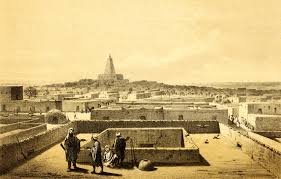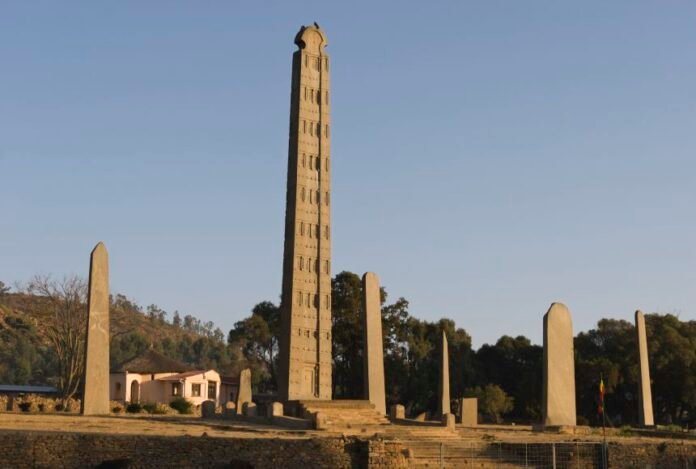Although little-known today, the Kingdom of Aksum was one of the most powerful kingdoms in the ancient world. Some Historians and schools of thought believe that the word ‘Aksum’ derives from a Semitic root, and means ‘a green and dense garden’ or ‘full of grass’
The Kingdom of Aksum, or the Aksumite Empire was a kingdom in East Africa and South Arabia from classical antiquity to the Middle Ages, based in what is now northern Ethiopia and Eritrea, and spanning present-day Djibouti and Sudan. Emerging from the earlier civilizations, the kingdom was founded in the first century. The city of Axum served as the kingdom’s capital for many centuries until it relocated to Kubar in the ninth century due to declining trade connections and recurring invasions.
The Kingdom of Aksum was considered one of the four great powers of the third century by the Persian prophet Mani, alongside Persia, Rome, and China. Aksum continued to expand under the reign of Gedara (c. 200–230), who was the first king to be involved in South Arabian affairs. His reign resulted in the control of much of western Yemen, such as the Tihama, Najran, al-Ma’afir, Zafar (until c. 230), and parts of Hashid territory around Hamir in the northern highlands until a joint Himyarite-Sabean alliance pushed them out. Aksum-Himyar conflicts persisted throughout the third century. During the reign of King Endubis, Aksum began minting coins that have been excavated as far away as Caesarea and southern India.

As the kingdom became a major power on the trade route between Rome and India and gained a monopoly of Indian Ocean trade, it entered the Greco-Roman cultural sphere. Due to its ties with the Greco-Roman world, Aksum adopted Christianity as its state religion in the mid-fourth century under Ezana (320s – c. 360). Following their Christianization, the Aksumites ceased construction of steles. The kingdom continued to expand throughout late antiquity, conquering Kush under Ezana in 330 for a short period of time and inheriting from it the Greek exonym “Ethiopia”.
Aksumite dominance in the Red Sea culminated during the reign of Kaleb of Axum (514–542), who, at the behest of the Byzantine emperor Justin I, invaded the Himyarite Kingdom in Yemen in order to end the persecution of Christians perpetrated by the Jewish king Dhu Nuwas. With the annexation of Himyar, the Kingdom of Aksum reached its largest territorial extent, spanning around 2,500,000 km2 (970,000 sq mi). However, the territory was lost in the Aksumite–Persian wars. Aksum held on to Southern Arabia from 520 until 525 when Sumyafa Ashwa was deposed by Abraha.
The kingdom’s slow decline had begun by the seventh century, at which point currency ceased to be minted. The Persian (and later Muslim) presence in the Red Sea caused Aksum to suffer economically, and the population of the city of Axum shrank. Alongside environmental and internal factors, this has been suggested as the reason for its decline. Aksum’s final three centuries are considered a dark age, and the kingdom collapsed under uncertain circumstances around 960. Despite its position as one of the foremost empires of late antiquity, the Kingdom of Aksum fell into obscurity as Ethiopia remained isolated throughout the Late Middle Ages.
The Aksumites developed their own system of writing and body of literature, and in the fourth century, Aksum became the first kingdom in Africa to convert to Christianity. Just why it did so isn’t certain, Harrower said, but the traditional story is that the Aksumite king Ezana was converted by a Greek-speaking youth from Tyre named Frumentius, who had been shipwrecked on the coast.
The ancient Kingdom of Aksum (or Axum) was a powerful civilization that flourished in the Horn of Africa, particularly in what is now northern Ethiopia and Eritrea, from around the 1st to the 8th centuries CE. Aksum was a major trading power, strategically located to control key routes connecting the Roman Empire, the Middle East, and India. It was known for its advanced urban society, impressive stone monuments, and its early adoption of Christianity.
Located beside the Red Sea in what are now northern Ethiopia, Eritrea and Yemen, the Kingdom of Aksum was a hub for ivory, gold, spices and textiles from the first century B.C. to the ninth century and traded with the Roman Empire.
But its origins may be much older, dating to the Pre-Aksumite period as far back as 1600 B.C., Michael Harrower, an associate professor of archaeology at Johns Hopkins University, told Live Science; the Aksumite period may only have been a change of the kingdom’s capital, from Yeha to Aksum.
After the seventh century, the Arab caliphates controlled the Red Sea and the Aksumite Kingdom declined, but later kingdoms continued their tradition of Christianity.
A major empire of the ancient world, the kingdom of Aksum arose in Ethiopia during the first century C.E. This wealthy African civilization thrived for centuries, controlling a large territorial state and access to vast trade routes linking the Roman Empire to the Middle East and India. Aksum, the capital city, was a metropolis with a peak population as high as 20,000. Aksum was also noteworthy for its elaborate monuments and written script, as well as for introducing the Christian religion to the rest of sub-Saharan Africa.
Aksum was situated in the highlands of northern Ethiopia, in a region called Tigray, near present-day Eritrea. Humans had inhabited the region and the valleys below since the Stone Age, and agrarian communities had been there for at least a millennium. But the origins of the kingdom of Aksum are mysterious. People from the kingdom of Saba, across the Red Sea on the southern part of the Arabian Peninsula, may have migrated into the area in the first millennium B.C.E. and influenced its culture. In this region, archaeologists have found evidence of a complex society called Di’amat, or D’MT, that preceded the rise of Aksum by several centuries. This culture was apparently based in the village of Yeha, in the Tigray highlands about 50 kilometers (31 miles) northeast of Aksum. Another city-state seems to have existed right next to Aksum on the Bieta Giyorgis Hill. Scientists and historians are still trying to understand the process of cultural and economic development that led to the growth of a wide polity in this region. Nevertheless, it is clear that by the first century C.E. or thereabouts, Aksum had emerged as a state to unify the area.
The local geography contributed to the rise of Aksum. The city is located some 2,000 meters (6,562 feet) above sea level, on a plateau. Its climate, rainfall patterns, and fertile soil made the area suitable for herding livestock and agriculture. Most importantly, the city was strategically positioned at the crossroads of trade routes running in every direction, from the East African coast to the continent’s interior.
Stay tuned for the continuation of this great African History Lesson Series..




